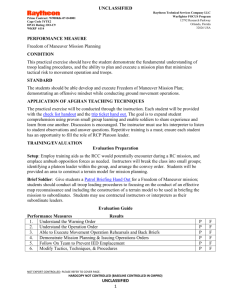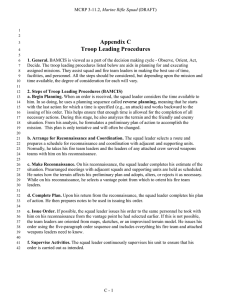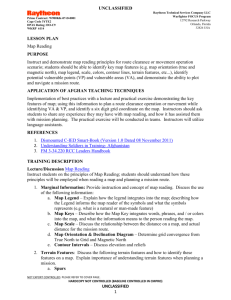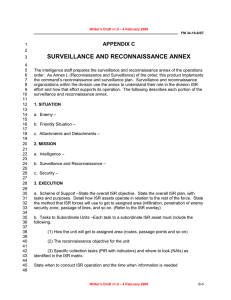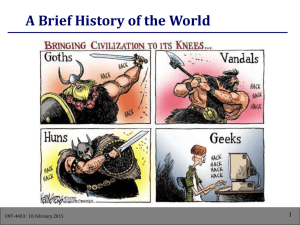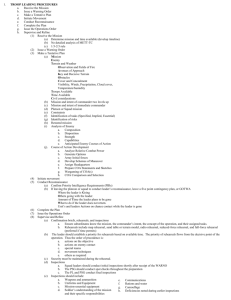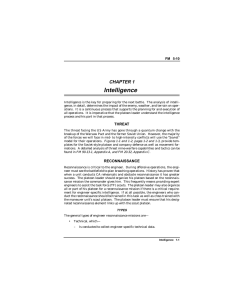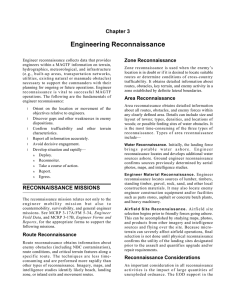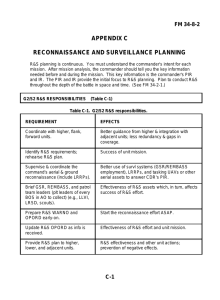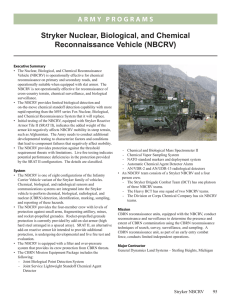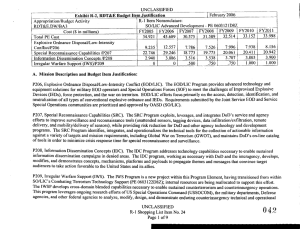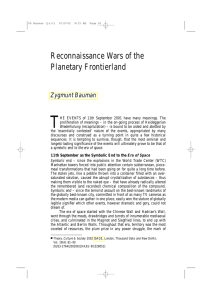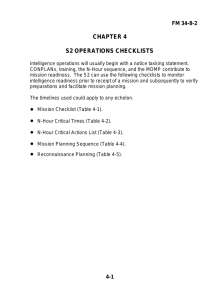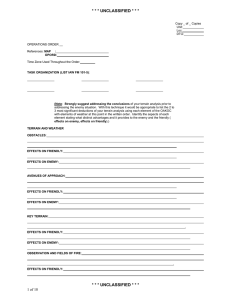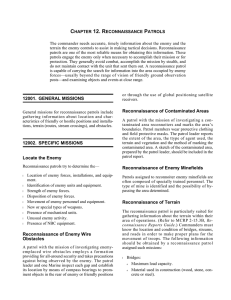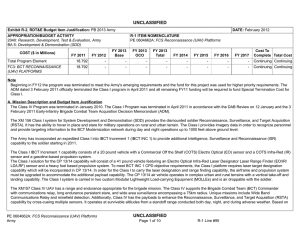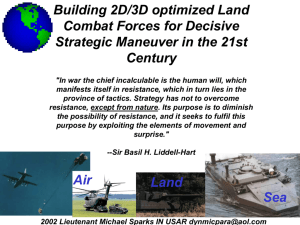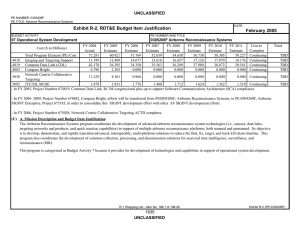Freedom of Maneuver Mission Planning Lesson Plan
advertisement
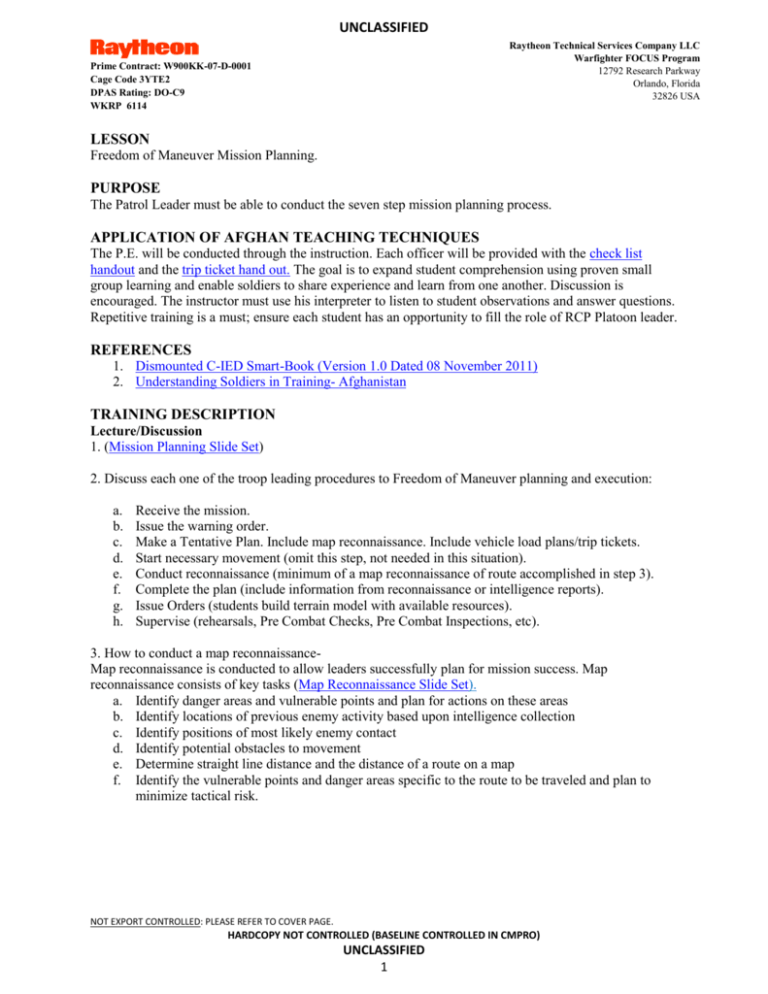
UNCLASSIFIED Raytheon Technical Services Company LLC Warfighter FOCUS Program 12792 Research Parkway Orlando, Florida 32826 USA Prime Contract: W900KK-07-D-0001 Cage Code 3YTE2 DPAS Rating: DO-C9 WKRP 6114 LESSON Freedom of Maneuver Mission Planning. PURPOSE The Patrol Leader must be able to conduct the seven step mission planning process. APPLICATION OF AFGHAN TEACHING TECHNIQUES The P.E. will be conducted through the instruction. Each officer will be provided with the check list handout and the trip ticket hand out. The goal is to expand student comprehension using proven small group learning and enable soldiers to share experience and learn from one another. Discussion is encouraged. The instructor must use his interpreter to listen to student observations and answer questions. Repetitive training is a must; ensure each student has an opportunity to fill the role of RCP Platoon leader. REFERENCES 1. Dismounted C-IED Smart-Book (Version 1.0 Dated 08 November 2011) 2. Understanding Soldiers in Training- Afghanistan TRAINING DESCRIPTION Lecture/Discussion 1. (Mission Planning Slide Set) 2. Discuss each one of the troop leading procedures to Freedom of Maneuver planning and execution: a. b. c. d. e. f. g. h. Receive the mission. Issue the warning order. Make a Tentative Plan. Include map reconnaissance. Include vehicle load plans/trip tickets. Start necessary movement (omit this step, not needed in this situation). Conduct reconnaissance (minimum of a map reconnaissance of route accomplished in step 3). Complete the plan (include information from reconnaissance or intelligence reports). Issue Orders (students build terrain model with available resources). Supervise (rehearsals, Pre Combat Checks, Pre Combat Inspections, etc). 3. How to conduct a map reconnaissanceMap reconnaissance is conducted to allow leaders successfully plan for mission success. Map reconnaissance consists of key tasks (Map Reconnaissance Slide Set). a. Identify danger areas and vulnerable points and plan for actions on these areas b. Identify locations of previous enemy activity based upon intelligence collection c. Identify positions of most likely enemy contact d. Identify potential obstacles to movement e. Determine straight line distance and the distance of a route on a map f. Identify the vulnerable points and danger areas specific to the route to be traveled and plan to minimize tactical risk. NOT EXPORT CONTROLLED: PLEASE REFER TO COVER PAGE. HARDCOPY NOT CONTROLLED (BASELINE CONTROLLED IN CMPRO) UNCLASSIFIED 1 UNCLASSIFIED Raytheon Technical Services Company LLC Warfighter FOCUS Program 12792 Research Parkway Orlando, Florida 32826 USA Prime Contract: W900KK-07-D-0001 Cage Code 3YTE2 DPAS Rating: DO-C9 WKRP 6114 Discuss with students a review of danger areas and vulnerable points and methods to identify these locations on a map. Discuss with students procedures for requesting data from higher headquarters on enemy activity in their area of operations. Using known enemy TTPs, discuss positions of most likely enemy contact and how to locate these areas on a map. Discuss obstacle to movement depending upon vehicle capabilities and road condition considerations. Instruct students to determine the distance of a route on a map using proper procedures to determine the straight-line distance and the road (curved line) distance between two points in meters with no more than 10 percent error. Practical Exercise Give students a Patrol Briefing Hand Out for a Freedom of Maneuver mission on the last day of training. They should conduct all troop leading procedures to focusing on the conduct of an effective map reconnaissance and including the construction of a terrain model to be used in briefing the mission to subordinates. They can use contracted instructors or interpreters as their subordinate leaders. Evaluation Trainer will ensure all troop leading procedures are followed. Retraining N/A TRAINING RESOURCES (Per Student to Instructor Ratio) Requirement Items List Quantity Infrastructure Classroom Ground sign awareness training lane 1 1 Support Force Protection Language Assistant Laptop computer Projector Projector Screen Presenter Remote/Green Laser Military Map Protractor Paper Pencil 1 1 1 1 1 1 Training Aids 5 25 25 25 SUMMARY This lesson should provide the student with a fundamental understanding of the troop leading procedures and the ability to plan and execute a mission that minimizes tactical risk. NOT EXPORT CONTROLLED: PLEASE REFER TO COVER PAGE. HARDCOPY NOT CONTROLLED (BASELINE CONTROLLED IN CMPRO) UNCLASSIFIED 2
